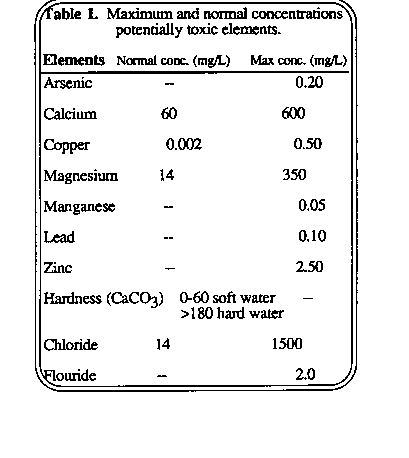
Sustainable Farming Index | Virtual Library | Magazine Rack
Search
| Ecological Solutions Roundtable
By Laurence Tisdall
Poultry production is one of the most efficient sectors of the agrifood industry. However, there are several often forgotten environmental factors which can result in important losses in productivity and profit.
Water quality is one important and sometimes forgotten aspect of animal production. According to Prof. Lague of Macdonald College poultry drinking water should be analysed at least once a year. Mineral analysis wlil provide information which could increase profits by decreasing stress on the birds.
Table 1 shows which concentrations are considered normal and which are potentially toxic. Even if tests do not show maximal mineral values, elevated quantities of minerals may adversely affect egg and/or meat production. For example E. Gardner and R. Chernos studied a turkey farm where the chloride level was 1065 mg/L, flouride 5.5 mg/L and sodium 896 mg/L, and found that these concentrations resulted in high mortality, foot problems and wet manure. On an egg producing farm where the chloride, sodium and bicarbonate levels were 329, 1048 and 1230 mg/L respectively, the chickens had diarrhea and egg shells were subject to pin sized holes. During a talk on water quality and poultry production at a conference in Victoriaville Québec(7 October 19871 Bernard Duboval stated that the chloride level should not surpass 200-250 mg/L since higher levels result in metabolic problems.

Hard water is often to be found in wells and is due to high levels of calcium and magnesium. Elevated levels of calcium may cause plugging of the water pipes with the possibility of reducing the available water for the chickens, but it is only when the levels are extreme that any health problems occur. Though magnesium does not usually present a problem by itself, in the presence of high sulfate concentrations (50 mg/L or greater) it will form magnesium sulfate (Epsom salt) which acts as a laxative. Iron does not seem to have much effect on poultry health but will react with certain antibiotics (oxytetracylines) if present at levels higher than 5 mg/L. It is best kept below 0.2 mg/L to avoid build up in the pipes and palatability problems.
Of late nitrates (which generally come from biological breakdown of animal and vegetable proteins, synthetic fertilizers and animal manures) have been found in ground water. T. Carter has stated that a nitrate level higher than 50 mg/L was dangerous for bird health (the normal level should be around 6.8 to 7.5 mg/L) since the nitrates will enter the blood stream directly from the intestine and can interfere with oxyhemoglobin production, reducing the ability of hemoglobin to carry oxygen in the blood.
Correcting mineral problems in water though often simple can be complex and expensive (iron and nitrates). To find out where to get water analysed, what treatment is best and most cost efficient, contact your local agronome.
Water in poultry units has also been known to be infected by bacteria. High numbers of conform bacteria are usually associated with high levels of nitrate and chloride or a septic tank or similar pollutant source close to the weel or spring. Non - coliform bacteria are usually a result of percolating surface water. When an elevated level of coliform bacteria exists this may suggest that pathogenic bacteria are present which can result in serious sickness since the high temperatures and availability of organic substances in the drinking troughs are ideal for bacterial growth. To avoid such a problem Prof. Lague has suggested rinsing the lines with 1 pert commercial bleach:2 parts water once or twice yearly. The chlorinated water needs to be in the pipes for 2-3 hours and then rinsed several times with fresh water. He also says that the water filters (ahead of the pressure reducer) are not changed often enough an many farms which can also result in bacterial contamination.
Another factor which may be overlooked is water temperature. Optimal temperature for chicken drinking is between 10-12 0C. In winter the water may intially be less than 5 0C until it warms up in the barn. One way to remedy this situation would be to nun the inside pipes to the back of the barn before circulating water to the chickens. Thus giving time for the water to warm up before reaching the birds.
Editor's note:
Next issue: An easily missed problem which may cost egg producers $15 000 annually.
For Further reading:
Carter T. A. Drinking water quality for poultry production. Poultry Digest. Feb. 1985.
Gardner E. and Chernos. R. Water quality on poultry farms. Ag Can Res. Stat.- Lethbridge. 1979.
Copyright © 1988 REAP Canada
Reprinted with permission. All rights reserved.
Info Request | Services | Become EAP Member | Site Map
Give us your comments about the EAP site
Ecological Agriculture Projects, McGill University (Macdonald
Campus),
Ste-Anne-de-Bellevue, QC, H9X 3V9 Canada
Telephone:
(514)-398-7771
Fax:
(514)-398-7621
Email: info@eap.mcgill.ca
To report problems or otherwise comment on the structure of this site, send mail to the Webmaster